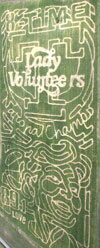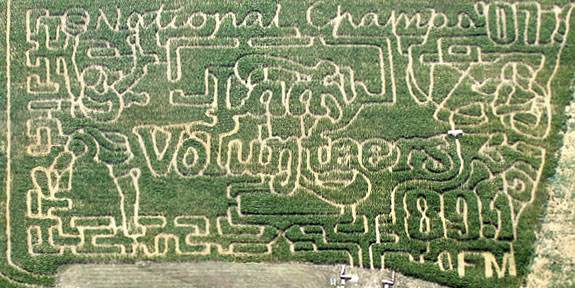We’re betting you’ve always wondered how all those intricate corn mazes are created each fall. In our new “How To” series, we’ll answer that question, followed each month in eTorch by other articles that will make you say, “So that’s how to do that!” To kick off the fall, two alumni share the secrets behind constructing a Vol-centric labyrinth of cornstalks.
The Experts
Business partners David Black (’99) and Ken Oakes (’90) run Oakes Farm in Corryton, Tennessee. The brothers-in-law have been operating a corn maze and pumpkin patch on their farm for eleven years.
Planting the Seeds
 Around the Fourth of July, enough seed goes into the ground to produce twelve to thirteen acres of corn. While other farmers typically plant in the spring, Black says waiting until summer keeps the corn green as long as possible. Once the first frost hits, the green is gone. Keeping the corn fertilized and weed-free is very important. Maze building can begin as soon as the corn reaches a foot tall up to ten feet tall.
Around the Fourth of July, enough seed goes into the ground to produce twelve to thirteen acres of corn. While other farmers typically plant in the spring, Black says waiting until summer keeps the corn green as long as possible. Once the first frost hits, the green is gone. Keeping the corn fertilized and weed-free is very important. Maze building can begin as soon as the corn reaches a foot tall up to ten feet tall.
Design Time
Oakes Farm hires a professional corn maze design firm from Idaho to work on the design and cut it into the cornfield. In 2007 and 2008, their design honored the Lady Vols and Pat Summitt. Oakes and Black worked with UT Athletics gathering logos and photos, which their firm turned into a design.
Cutting Images
Using state-of-the art technology, the design firm geo-references the cornfield to get the lay of the land. The image is integrated into a GPS system that acts much like a road map for the tiller driver. The tiller cuts the corn down and flattens it. When the maze is done, there’s a soft dirt path for those who are brave enough to venture through it.
Getting the Word Out
Black says no corn maze can be successful without marketing and preparation. “It’s not necessarily an ‘if you build it, they will come’ kind of situation,” he says. “You have to do your job, too.”
Ideas for other “How To” features? E-mail torch@tennessee.edu.

